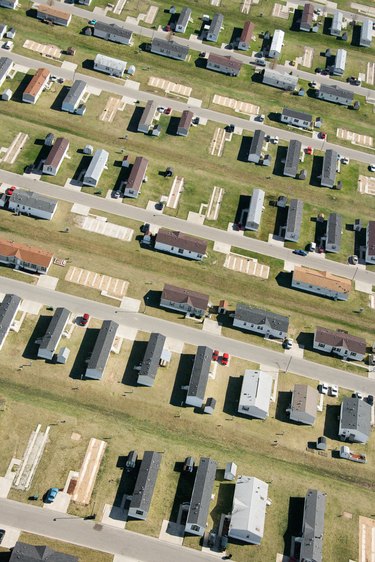
A foundation is the main supporting structure for a house or other building. The foundation must be solid in order to support a floor without sagging and to make sure the structure stays firmly in place. There are many kinds of foundations, including concrete block, poured concrete, and post and block foundations, often called post and pier foundations. In some cases a foundation may combine two of these types in order to provide more complete support for the building, such as a perimeter of poured concrete combined with internal post and block support.
Foundation Basics
Video of the Day
The foundation of a building serves several purposes. One of its main functions is to support the building, and it does this by holding up the walls and the load-bearing beams that go under the floor. A foundation is also used as a way to create a level surface for the base of a building. Leveling can take place above or below the foundation, depending on the type and size of the foundation. A foundation also serves the purpose of raising a structure off the ground to minimize opportunities for rot.
Video of the Day
Materials
Concrete is the material most often used to make foundations, but various other types of materials are sometimes used as well. Stone, treated lumber, brick and cement blocks are all common foundation materials. Sometimes materials are combined, such as with post and block foundations, where both wood and cement blocks may used together or the foundation may be a combination of poured concrete and cement blocks.
Methods
A post and block foundation consists of a series of concrete or cement blocks placed on gravel or poured concrete footings. The size and depth of the footings vary based on the overall size of the structure and the reginal climate. The type of soil can impact footing size; soft, loamy soil requires deeper footings than hard clay or gravel. One or more concrete blocks is placed on each footing, and they are built up to just below floor level. These support either a series of heavy posts that run the width of the house and touch the floor beams or short posts that are placed individually at each location. This is a common type of foundation for a mobile home, modular home or small cabin.
Considerations
A post and block foundation is not appropriate in areas where earthquakes are common, since it doesn't require a great deal of shaking to shift a home off of one. In very cold areas footings must extend below the frost zone so they are not shifted by changes in the temperature of the soil. In areas where there is a risk of high winds, mobile homes and other structures set on post and block foundations can get added stability by cables anchored in the ground.